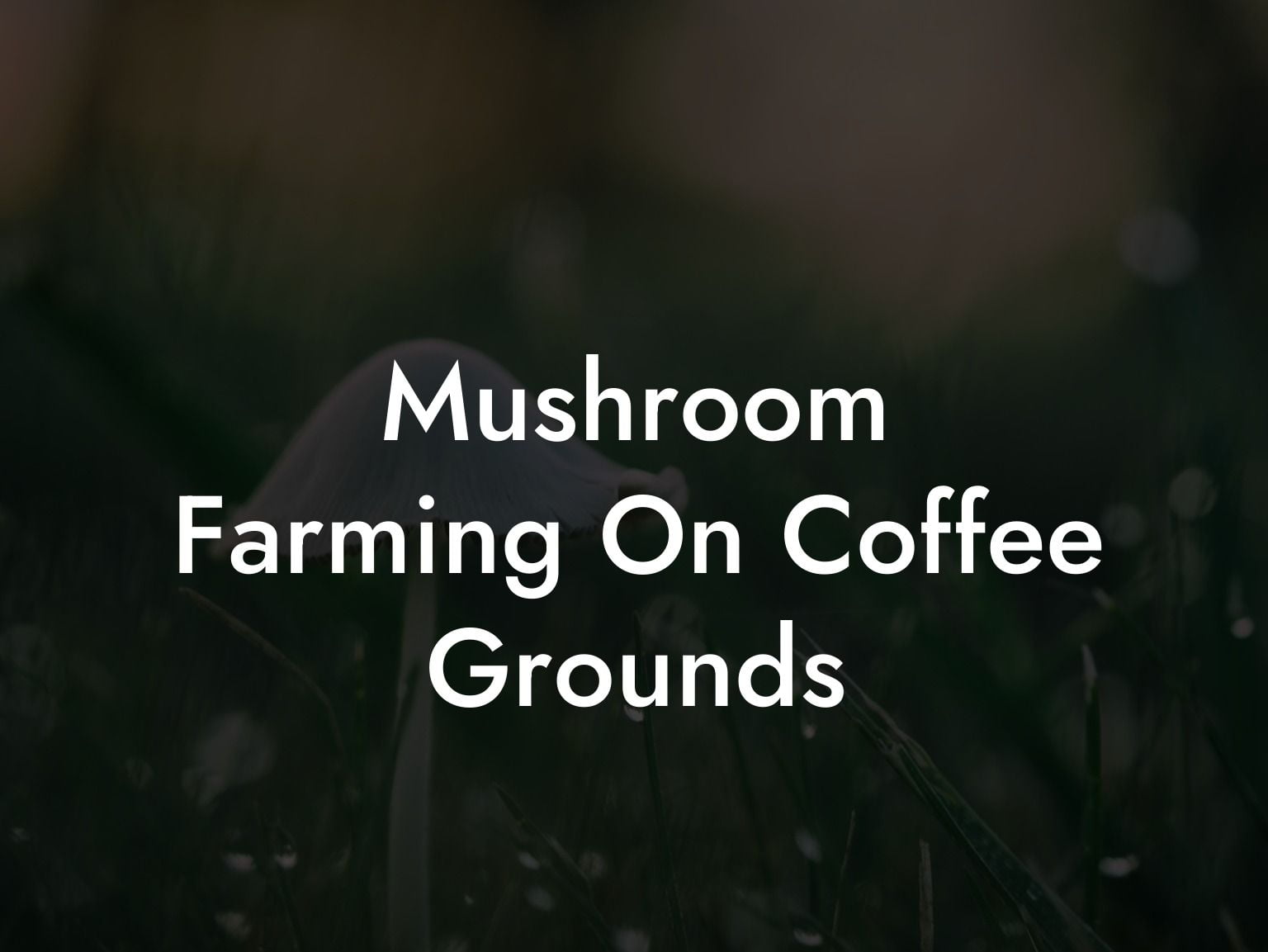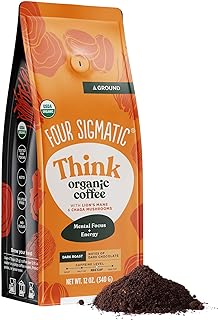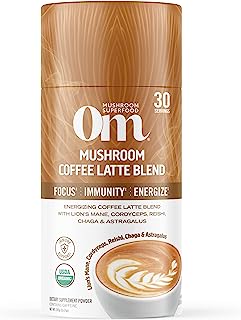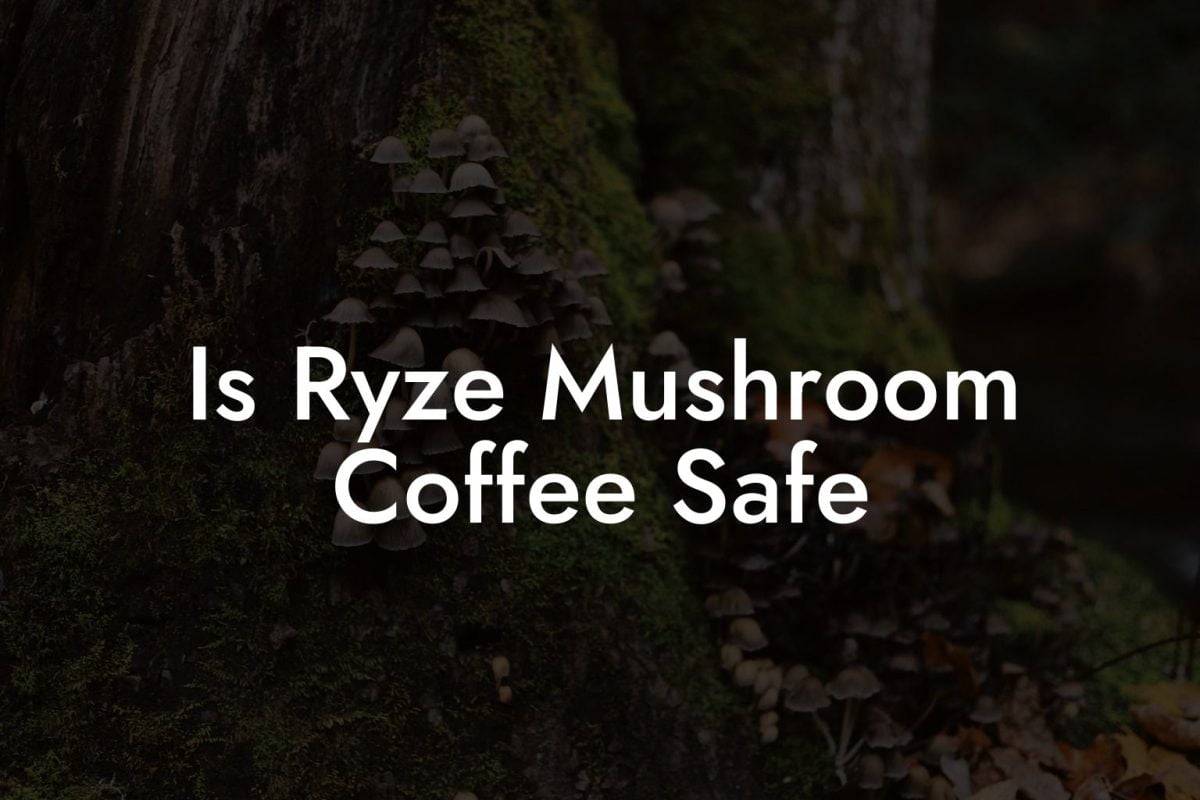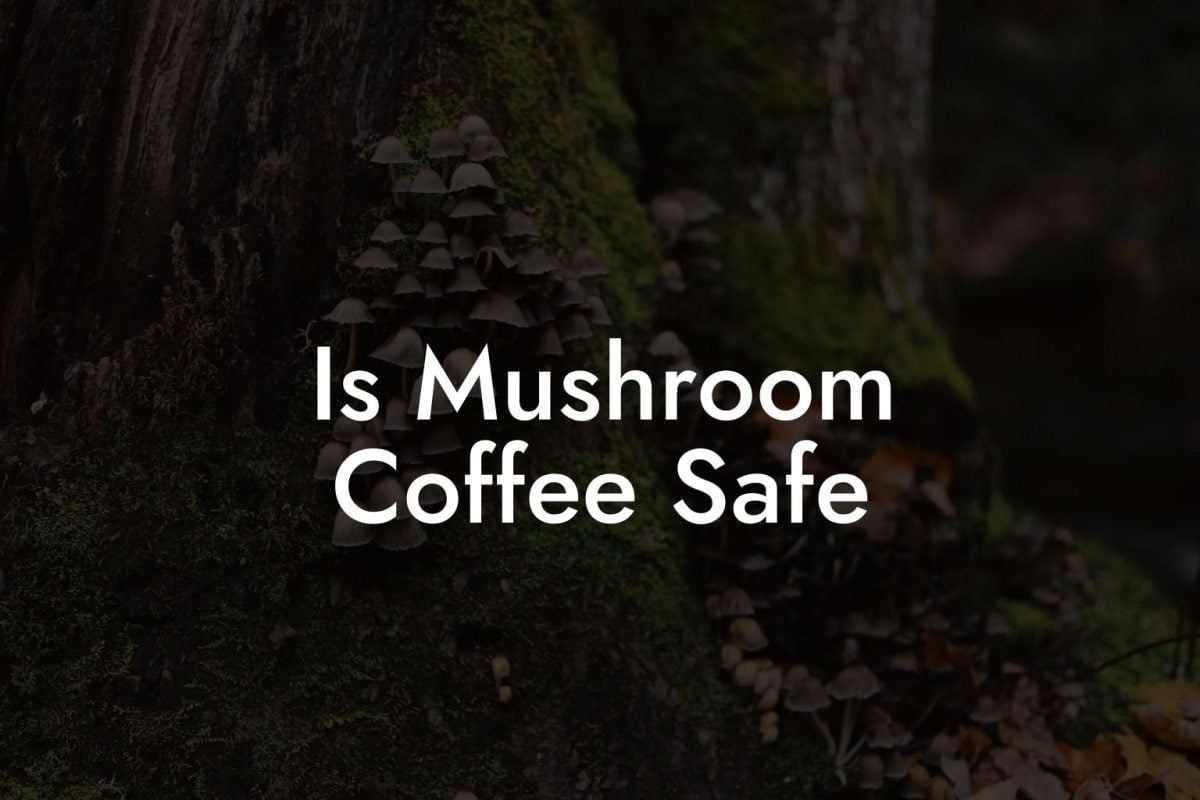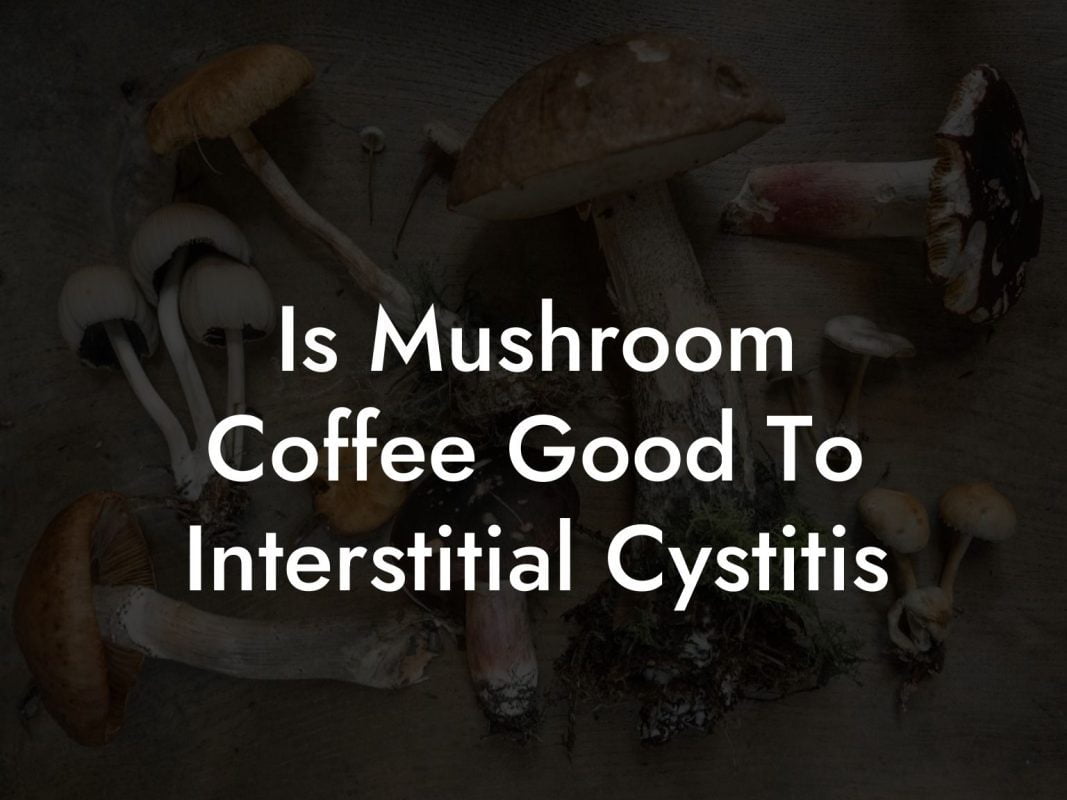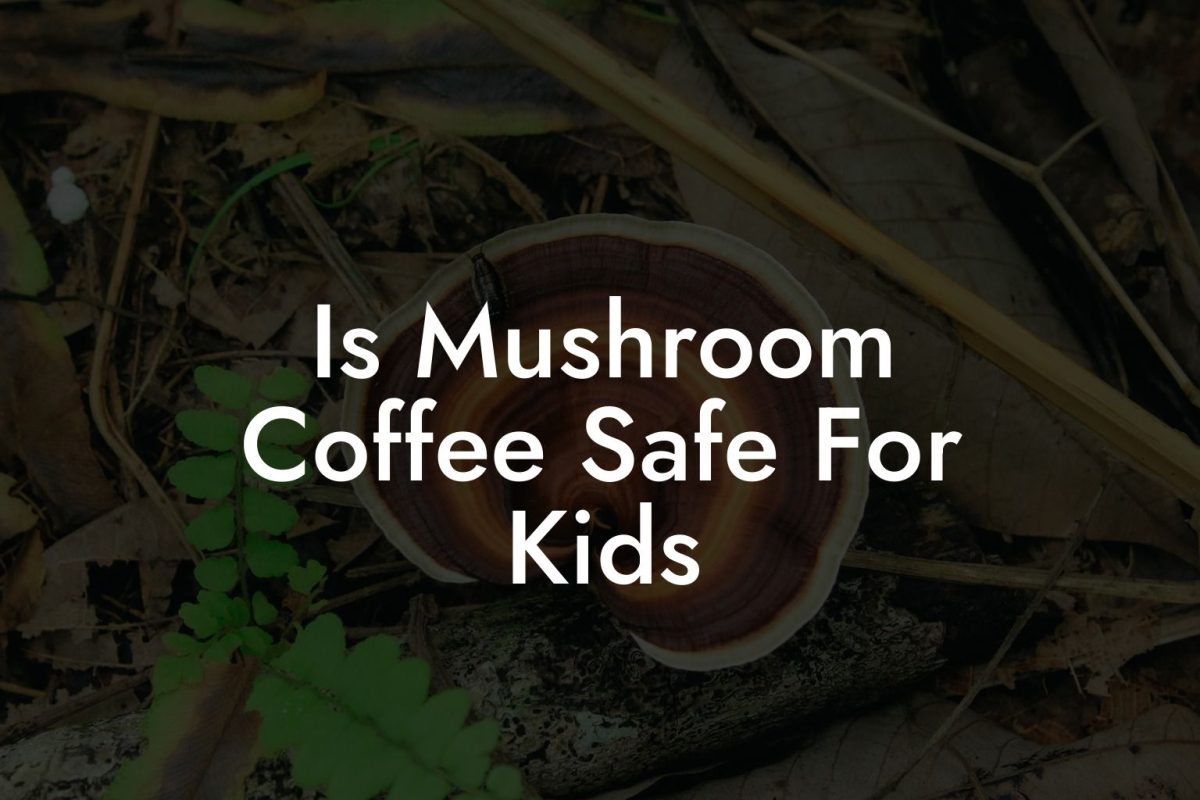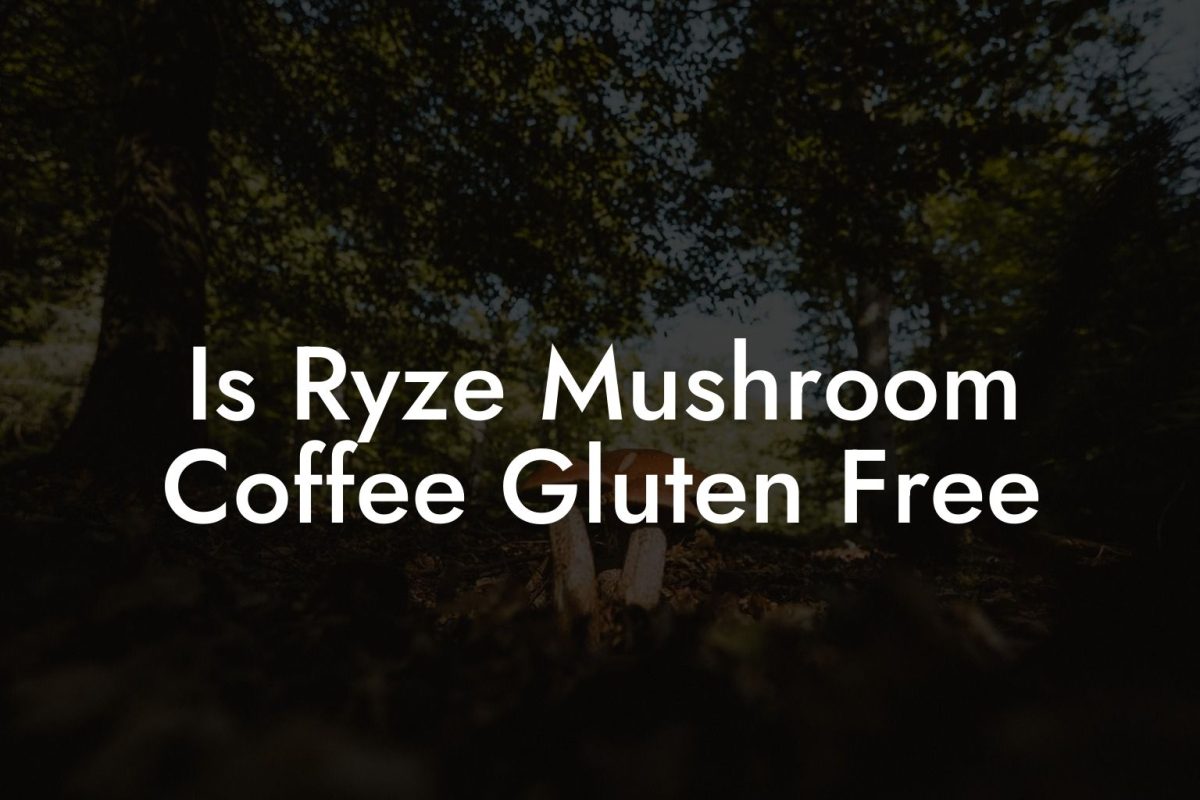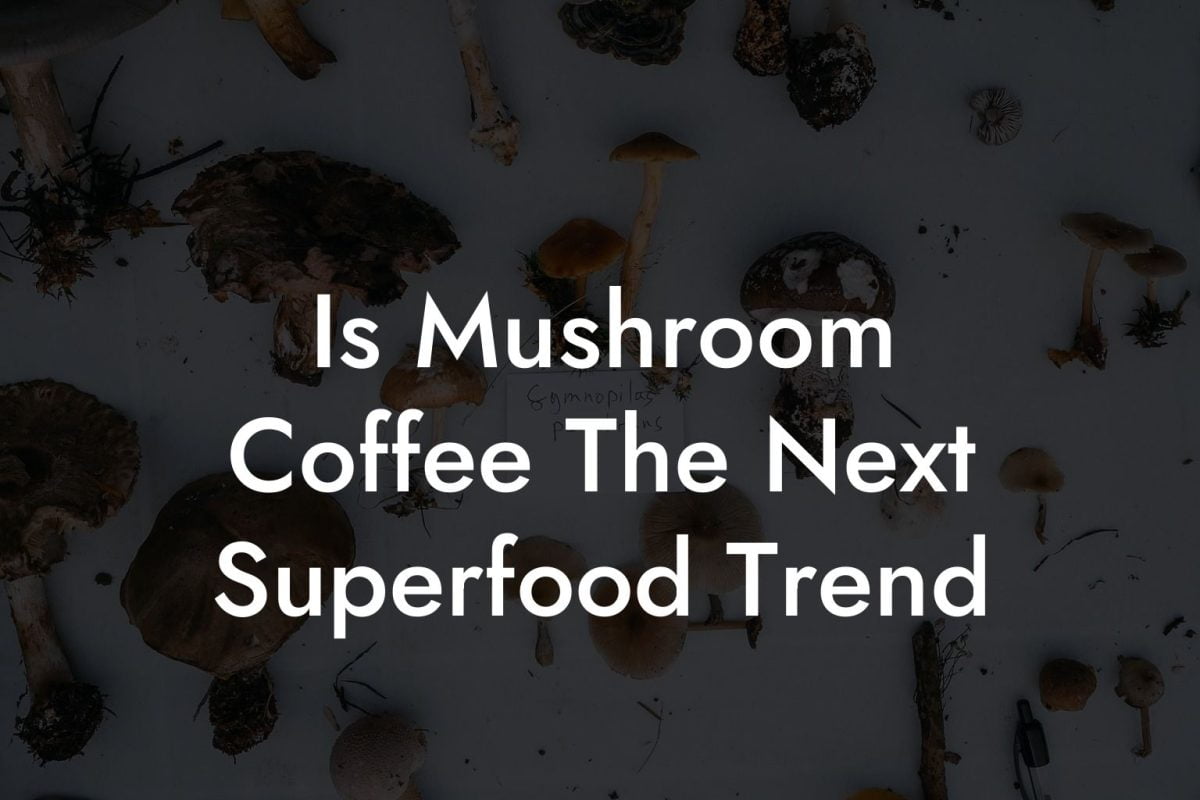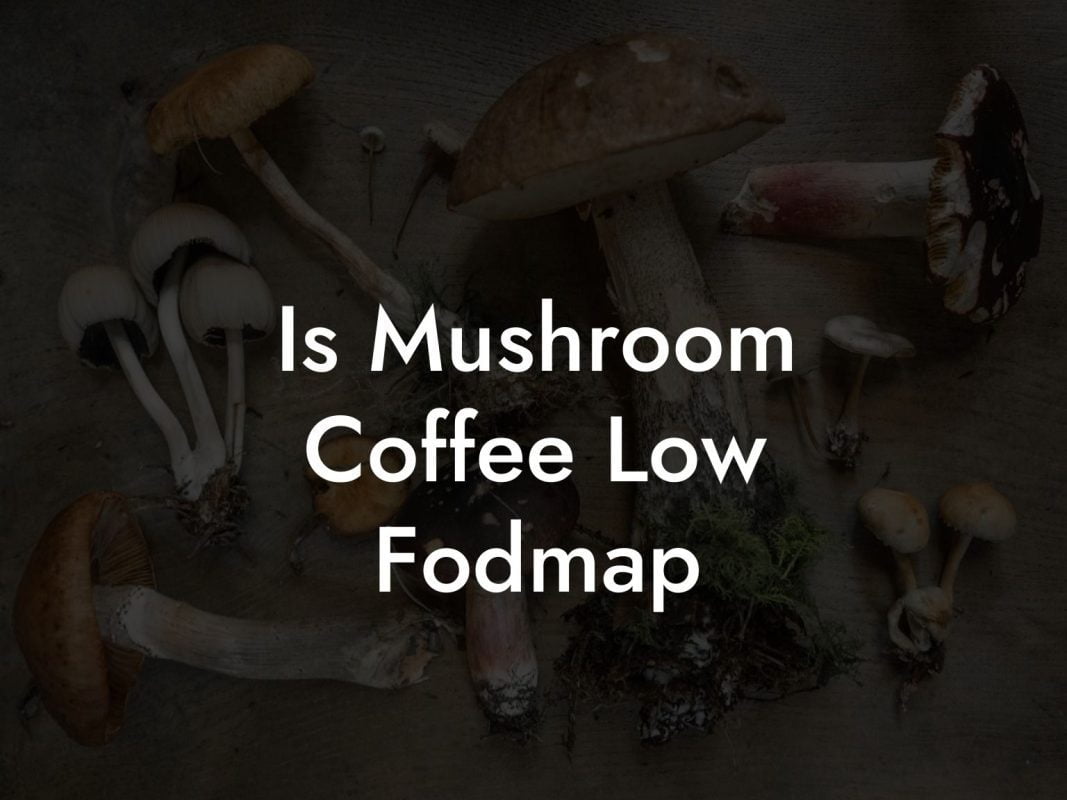Ever thought your beloved coffee grounds could be transformed into a secret superfood for your mind and body? Welcome to the quirky, colorful universe of mushroom farming on coffee grounds, a trend that's as unexpected as pairing avocado toast with a side of truffle oil. In this guide, we dive deep into the science, art, and pure fun of turning your leftover coffee into a thriving mushroom garden that pairs perfectly with your morning mushroom coffee.
Quick Links to Useful Sections
- Introduction to Mushroom Farming on Coffee Grounds
- Why Coffee Grounds? The Science Behind the Magic
- Mushroom Species Perfect for Coffee Grounds
- The Ultimate Guide to Setting Up Your Coffee Ground Mushroom Farm
- Step 1: Sourcing and Sterilizing Coffee Grounds
- Step 2: Mixing the Perfect Substrate
- Step 3: Inoculation – Meet the Mycelium
- Step 4: Incubation – Let the Magic Happen
- Step 5: Fruiting Initiation – Harvest Time is Near
- Step 6: Harvest and Enjoy
- Maximizing Yields with Expert Tips and Techniques
- The Sustainability Factor: Environmental and Economic Benefits
- Complementary Techniques: Integrating Other Organic Materials
- Mixing with Sawdust and Wood Chips
- Incorporating Straw or Hay
- Boosting with Organic Compost
- Case Studies: Real-Life Transformations in Urban Mushroom Farming
- Case Study 1: The Hip Café Owner’s Green Revolution
- Case Study 2: The College Dorm Urban Farmer
- Case Study 3: Community Gardens and the Local Harvest
- Challenges and How to Troubleshoot Them
- Contamination Concerns
- Moisture Management Issues
- Temperature Fluctuations
- Slow Colonization
- Integrating Mushroom Coffee into Your Daily Brew
- Resources and Community Support: Your Next Steps
- Future Trends in Mushroom Farming and Coffee Sustainability
- Frequently Asked Questions About Mushroom Farming on Coffee Grounds
- Embracing the Future with Coffee Grounds and Mushrooms
Introduction to Mushroom Farming on Coffee Grounds
Picture this: your daily caffeine fix leaves behind a trail of rich, organic coffee grounds that most of us would toss into the trash without a second thought. But what if these seemingly useless remnants are actually a hidden goldmine, a nutrient-dense substrate ready to nurture an array of gourmet and medicinal mushrooms? That's right, mushroom farming on coffee grounds is not only eco-friendly but also an innovative way to cultivate crops that are overflowing with flavor, nutritional benefits, and even a dash of sustainable chic.
For the eco-conscious Gen-Z and millennial crowd, this method of cultivation ties together the love for sustainability, urban gardening, and the ever-popular wellness trend of mushroom coffee. It’s about rethinking waste and transforming it into something remarkable. So whether you’re a DIY enthusiast or a sustainability advocate, buckle up, you're about to join a movement that turns the mundane into something magnificently magical.
Why Coffee Grounds? The Science Behind the Magic
Coffee grounds are nature’s gift to mushrooms. Rich in nitrogen, organic compounds, and a slew of other micro-nutrients, they create an ideal environment for mycelium, the sprawling network of fungal threads that eventually give rise to mushrooms. When used as a growing substrate, coffee grounds offer a perfect balance of moisture retention and aeration, essential for robust mycelial growth.
There's a beautiful irony here: the very substance that wakes you up in the morning effortlessly fuels the growth of mushrooms, which in turn are the cornerstone of that sought-after mushroom coffee trend. With enough coffee grounds on hand from local cafés or even your home brew sessions, you can embark on an urban farming journey that is as rewarding as it is sustainable.
Looking For The Best Mushroom Coffee? You'll Love These:
Integrating coffee grounds into your mushroom farming practices not only reduces waste but also enriches the soil with beneficial microorganisms, playing an essential role in a broader organic lifecycle. Think of it as the circle of life, but with an extra kick of caffeine!
Mushroom Species Perfect for Coffee Grounds
Not all mushrooms are created equal, especially when it comes to choosing the right cultivars for coffee ground substrates. However, a few superstar species have shown their prowess in flourishing on this rich, earthy medium:
- Oyster Mushrooms (Pleurotus spp.): Known for their rapid colonization, versatility, and delicious flavor, oyster mushrooms are the go-to choice for coffee ground cultivation. Their ability to break down complex organic matter means they can transform your coffee waste into a gourmet delicacy.
- Shiitake Mushrooms (Lentinula edodes): Revered for their earthy, umami flavor, shiitakes can also be cultivated on coffee grounds with a few tweaks. Although they prefer hardwood substrates, mixing in coffee grounds adds a unique twist to their growth cycle.
- Maitake (Grifola frondosa): Also called “Hen of the Woods,” these mushrooms thrive in nutrient-rich media and are perfect for those who appreciate both culinary and medicinal benefits.
- Reishi Mushrooms (Ganoderma lucidum): Dubbed the “mushroom of immortality,” reishi mushrooms have been used for centuries in traditional medicine. They might take a bit longer to colonize, but the resulting health benefits are well worth the wait.
The secret is to play around with different blends and find the right match for your taste buds and available resources. Experimentation is the name of the game in this green revolution, and each attempt adds to your body of knowledge on sustainable urban farming.
The Ultimate Guide to Setting Up Your Coffee Ground Mushroom Farm
Ready to get your hands dirty? Here’s a step-by-step walkthrough to set up your very own mushroom farm using coffee grounds. Whether you’re doing it on your apartment balcony or a reclaimed urban lot, these guidelines are as accessible as your local café.
Step 1: Sourcing and Sterilizing Coffee Grounds
First things first, gather your coffee grounds. Reach out to local coffee shops or simply save the grounds from your morning brew. It’s crucial to use fresh, uncontaminated coffee grounds to avoid unwanted bacteria or mold spores.
Once collected, you’ll want to pasteurize them. This process involves gently heating the coffee grounds to kill harmful organisms while preserving the beneficial bacteria that assist in mycelial growth. You can do this by steaming or microwaving, just make sure you maintain moisture and avoid overheating.
Step 2: Mixing the Perfect Substrate
While coffee grounds are packed with nutrients, they benefit from a partner in crime. Mix the pasteurized grounds with other organic materials such as straw, sawdust, or even a dash of compost. This creates a more balanced substrate that improves aeration and moisture retention.
The ratio of coffee grounds to added substrates varies depending on the mushroom species; however, a common starting mix is 50/50. Adjust as needed based on your observations and growth performance.
Step 3: Inoculation – Meet the Mycelium
Inoculation is essentially the act of “planting” your mushroom spawn into the prepared substrate. For a smooth process, ensure your work area is clean and sanitized to prevent contamination. Sprinkle or mix the mushroom spawn evenly with your substrate, ensuring maximum contact between the mycelium and the nutrient-rich medium.
The environment should be ideal for mycelial colonization, keep it in a warm, dark, and humid space. A repurposed storage bin or a dedicated grow tent works wonders in creating a controlled microenvironment.
Step 4: Incubation – Let the Magic Happen
Now comes the waiting game. During the incubation phase, your mycelium will colonize the substrate over a period of about 10-14 days. Keep the container in a dimly lit area with a stable temperature typically between 20-25°C (68-77°F). Avoid direct sunlight, which can dry out the substrate and stunt growth.
Check periodically for signs of contamination. A healthy mycelial network is usually white and feathery. If you notice any discolored spots or unusual odors, it might be time to scrupulously clean your workspace or adjust moisture levels.
Step 5: Fruiting Initiation – Harvest Time is Near
Once the substrate is fully colonized, it’s time to introduce conditions that trigger fruiting. This involves lowering the temperature slightly, increasing the light, and introducing fresh air. Mist your substrate lightly to maintain humidity without causing waterlogging.
Patience is key here. Fruiting bodies (the mushrooms) will start to emerge within 5-7 days under optimal conditions. Once they appear, monitor their growth and adjust environmental factors as necessary.
Step 6: Harvest and Enjoy
The final reward is the harvest. Gently twist or cut your mushrooms at the base when they reach optimal size. Remember, timing is crucial, harvest too early and you miss out on the full flavor, too late and the mushrooms may lose their texture.
Enjoy your bounty in your next cup of mushroom coffee or a gourmet stir-fry. Not only have you created a sustainable food source, but you’ve also contributed to reducing waste and promoting environmental stewardship.
Maximizing Yields with Expert Tips and Techniques
Mushroom farming on coffee grounds isn’t just a one-and-done project, it’s an evolving art that improves with each cycle. To help you get the most out of your urban mushroom farm, here are some expert tips and techniques:
- Moisture Management: Coffee grounds can dry out quickly. Use a spray bottle to maintain consistent moisture levels without saturating the substrate.
- Air Circulation: Good ventilation is key. Stagnant air can encourage contaminants, while too much airflow might dry out your substrate. Strike a careful balance by adjusting the container’s openings.
- Temperature Tweaks: Experiment with slight temperature adjustments during incubation to see what works best for your chosen mushroom species. Small changes can have big impacts on growth rates.
- Sanitation Protocols: Maintain a clean workspace. Wash your hands, sterilize your tools, and ensure your growing environment is free from dust and other contaminants.
- Lighting Strategies: While mushrooms don’t need light to grow, exposure to indirect light during fruiting helps guide their development. A simple LED lamp on a timer can work wonders.
- Substrate Adjustments: If you notice your mushrooms are not thriving, tweak your substrate mix by adding more organic matter or varying the ratios. Experimentation is part of the fun.
Each farm is unique, so take notes on what works best in your setup. The world of mushroom cultivation is as much about science as it is about creative experimentation!
The Sustainability Factor: Environmental and Economic Benefits
Incorporating coffee grounds into mushroom farming isn’t merely a trendy experiment, it’s a step toward a more sustainable future. Here’s why:
Eco-Friendly: By reusing coffee grounds that would otherwise contribute to landfill waste, you’re reducing your environmental footprint. This closed-loop approach not only minimizes waste but also demonstrates innovative recycling practices.
Cost-Effective: Mushroom substrates can be expensive, but coffee grounds are often available for free from local cafés or your own kitchen. This makes mushroom farming an affordable venture for urban gardeners and small-scale farmers alike.
Health Benefits: Mushrooms are nutritional powerhouses. They’re rich in antioxidants, vitamins, and minerals, and some varieties have even been linked to immune-boosting properties. Combined with your favorite coffee beverage, you have a unique blend of nutrition and energy.
Community Impact: Start a local initiative! Urban mushroom farms can transform community gardens, support local businesses, and create new opportunities for sustainable agriculture education. Whether shared through workshops or community-supported agriculture (CSA) programs, your tiny mushroom farm could spark a larger movement.
Complementary Techniques: Integrating Other Organic Materials
While coffee grounds are fantastic as a base, you shouldn’t stop there. Integrating other organic materials into your substrate can enhance the nutritional profile and improve overall yields. Let’s look at a few innovative combinations:
Mixing with Sawdust and Wood Chips
Many mushrooms, especially shiitake, traditionally thrive on hardwood sawdust or wood chips. By mixing these with coffee grounds, you add a high-cellulose component that supports vigorous mycelial expansion. This blend mimics the mushrooms’ natural habitat, leading to richer flavor and more robust fruiting.
Incorporating Straw or Hay
Straw adds a fibrous texture to your substrate, promoting better aeration and water retention. When combined with coffee grounds, straw creates a balanced environment that is particularly well-suited for oyster mushrooms. Just ensure the straw is clean and preferably pasteurized before mixing.
Boosting with Organic Compost
Organic compost, with its diverse microbial community, can be the secret ingredient that supercharges your substrate. The compost’s trace nutrients complement the rich nitrogen in coffee grounds, offering an all-around hearty environment for your mushrooms.
Experiment with these combinations, and adjust your ratios until you find the perfect blend that works for your specific climate and mushroom species.
Case Studies: Real-Life Transformations in Urban Mushroom Farming
Nothing illustrates the magic of mushroom farming on coffee grounds better than real-life success stories. Here are a few case studies that showcase how ordinary citizens turned their coffee waste into extraordinary edible treasures:
Case Study 1: The Hip Café Owner’s Green Revolution
Elena, a vibrant café owner in downtown Brooklyn, began collecting coffee grounds daily from her café. Fascinated by sustainability trends, she experimented with oyster and shiitake mushrooms on the surplus grounds. Within weeks, her experiments blossomed into a thriving mini-mushroom farm that not only reduced waste but also became a unique selling point for her café. Patrons loved the story behind their morning brew, a narrative that blended local sustainability with gourmet flavors.
Case Study 2: The College Dorm Urban Farmer
In a small college dorm room, Jason, a biology major with a penchant for experimental living, turned to coffee ground mushroom farming as both a side hustle and a stress-relief hobby. Using a repurposed shoebox and salvaged coffee grounds from the campus café, he successfully cultivated a modest crop of oyster mushrooms. His dorm room experiments soon became the talk of campus, sparking interest in urban agriculture and sustainable practices among his peers.
Case Study 3: Community Gardens and the Local Harvest
In a bustling urban neighborhood, a community garden initiative took off by incorporating coffee ground-based mushroom cultivation. Local residents pooled their coffee waste and worked together to set up a communal mushroom farm. This project not only provided fresh, locally grown mushrooms but also acted as an educational hub for sustainability, waste reduction, and organic farming practices. The community spirit and fresh harvest inspired many to replicate the model in other urban areas.
These case studies prove that regardless of your background, location, or available space, mushroom farming on coffee grounds is a transformative, accessible practice that fits seamlessly into modern urban lifestyles.
Challenges and How to Troubleshoot Them
Even innovative endeavors come with their share of challenges. Here are some common hurdles you might face when cultivating mushrooms on coffee grounds, and practical solutions to overcome them:
Contamination Concerns
Contamination is the arch-nemesis of any fungus farmer. Unwanted bacteria or mold may creep in if the substrate is not properly pasteurized or if the environment isn’t adequately sanitized. The solution? Maintain strict hygiene, use proper sterilization techniques, and keep tools and workspaces clean. If contamination appears, isolate the affected portion immediately to prevent it from spreading.
Moisture Management Issues
Coffee grounds can go from damp to dessicated in no time. Maintaining punctilious moisture levels is key. Use a digital hygrometer to monitor humidity and adjust your misting schedule accordingly. If you notice the substrate drying out, cover it temporarily with a breathable cloth or plastic wrap with ventilation holes.
Temperature Fluctuations
Urban environments can be unpredictable. Sudden temperature shifts might slow down or disrupt mycelial growth. To combat this, consider insulating your growing area or using a grow tent with a built-in thermostat to keep conditions as stable as possible.
Slow Colonization
Sometimes, mycelium just needs a bit more time to do its thing. If you notice slower colonization, ensure that your substrate isn’t too dense or overly wet, as either condition can impede growth. Adjusting the substrate mix with additional organic material can help improve aeration.
Remember, every setback is just an opportunity to refine your technique. Experiment, make adjustments, and soon you’ll be harvesting mushrooms like a seasoned urban farmer.
Integrating Mushroom Coffee into Your Daily Brew
Now that you’re cultivating mushrooms with coffee grounds, why not take that innovation one step further? Mushroom coffee is making waves as a unique, health-boosting beverage that blends the best of both worlds, caffeine and adaptogenic mushrooms.
Brew your regular cup of coffee and infuse it with a shot of finely powdered medicinal mushrooms like reishi or lion’s mane. The result is a smooth, earthy drink that is said to enhance focus, boost immunity, and provide long-lasting energy without the notorious jitters. It’s a perfect beverage for the modern, mindful consumer who values both sustainability and holistic health.
Making your very own mushroom coffee not only supports your local mushroom farming efforts but also adds a gourmet twist to your daily routine. Experiment with ratios until you find the perfect blend that fits your personal taste and energy needs.
Resources and Community Support: Your Next Steps
Ready to take the plunge into mushroom farming on coffee grounds? There’s a wealth of resources and communities out there waiting to help you along the journey. Here are a few ways to expand your knowledge and connect with like-minded urban farmers:
- Online Forums and Social Media Groups: Platforms like Reddit, Facebook, and Instagram are teeming with communities dedicated to urban farming, mushroom cultivation, and eco-friendly living. Joining these groups provides not only advice and troubleshooting tips but also a sense of camaraderie and inspiration.
- Workshops and Local Classes: Look for workshops in your area that focus on sustainable agriculture and mushroom farming. Many urban farming initiatives offer hands-on sessions that can provide invaluable insights into best practices and innovative techniques.
- Books and E-Guides: There’s a growing library of literature on mushroom cultivation. From detailed manuals on mycology to digital resources about sustainable living, take advantage of the multitude of guides available to deepen your expertise.
- Collaborative Projects: Consider partnering with local cafés, community gardens, or urban farms. Collaborative projects often pave the way for exciting innovations and expand the impact of your sustainable efforts.
Every great journey is easier when you’re not alone, reach out, share your experiences, and learn from others who have transformed coffee waste into something spectacular.
Future Trends in Mushroom Farming and Coffee Sustainability
As more people pivot toward sustainable and eco-friendly lifestyles, mushroom farming on coffee grounds is gaining momentum. The future of this practice is not only rooted in recycling waste but also in advanced techniques like precision agriculture and smart farming. Imagine integrating digital sensors to monitor substrate moisture and temperature, or using mobile apps to schedule and document your cultivation processes!
Researchers are exploring hybrid substrates, genetic optimization of mushroom strains, and even urban vertical farming systems that could scale these practices to new heights. For tech-savvy urban gardeners, the convergence of sustainable agriculture with modern technology opens up endless possibilities, from automated misting systems to AI-driven growth analytics.
Stay ahead of the curve by subscribing to newsletters, following industry blogs, and attending virtual conferences on sustainable agriculture. The intersection of technology, sustainability, and culinary innovation promises to redefine the way we think about food production and waste management.
Frequently Asked Questions About Mushroom Farming on Coffee Grounds
Here are some of the most commonly asked questions about turning coffee grounds into a fruitful mushroom farm:
1. Why are coffee grounds ideal for growing mushrooms?
Coffee grounds are rich in nitrogen and other nutrients, providing an excellent substrate that supports vigorous mycelial growth while also being eco-friendly.
2. Which mushroom species grow best on coffee grounds?
Oyster mushrooms are among the fastest-growing and most adaptable to coffee ground substrates. Other species like shiitake, maitake, and even reishi can also thrive with the right conditions.
3. Do I need any special equipment to start mushroom farming at home?
Not really, you’ll need basic items like containers or grow tents, a spray bottle for moisture, and clean, sanitized workspaces. More advanced setups may involve thermostats and hygrometers, but you can start very simply.
4. How do I prevent contamination during my mushroom farming process?
Ensuring cleanliness during substrate preparation and inoculation is key. Pasteurize your coffee grounds, maintain a sterile work environment, and monitor for mold or bacteria regularly.
5. Can mushroom coffee really provide health benefits?
Yes, incorporating medicinal mushrooms like reishi and lion’s mane into your coffee can boost immunity, enhance mental clarity, and provide a more balanced energy boost compared to regular coffee.
6. How long does it take from inoculation to harvest?
Typically, the incubation phase takes about 10-14 days, with fruiting starting within 5-7 days after full colonization, depending on environmental conditions and the mushroom species.
7. What can I do with my harvested mushrooms?
Enjoy them fresh in your recipes, add to your mushroom coffee, or even dry them for later use, mushrooms add a unique flavor boost to a variety of dishes.
8. Are there any risks I should be aware of?
As with any organic cultivation process, always be mindful of contamination. Following proper sterilization and handling procedures minimizes risks and ensures a healthy yield.
Embracing the Future with Coffee Grounds and Mushrooms
The journey of mushroom farming on coffee grounds is a testament to creativity, sustainability, and the power of transformation. It’s a bold step toward redefining what waste means in a world increasingly focused on eco-friendly living. By harnessing the natural properties of coffee grounds, you’re not only cultivating an exceptional source of gourmet mushrooms but also contributing to a larger conversation about environmental responsibility and sustainable urban agriculture.
This innovative method bridges the gap between the old and the new, a blend of age-old organic cultivation techniques infused with modern sustainability practices that resonate with today’s eco-minded community. Your small-scale mushroom farm might start as a personal experiment, but it has the potential to inspire a movement toward greener, healthier living.
So, next time you savor that aromatic cup of coffee, remember that its afterlife might just be a bustling mushroom garden, quietly contributing to a healthier planet and a tastier tomorrow.
Explore, experiment, and enjoy every moment of this transformative journey. The future of sustainable agriculture is brewing right in your own kitchen, waiting for you to take the leap and let your creativity bloom, like mushrooms after the rain!
Embrace the innovation. Cherish the sustainability. And enjoy the flavorful fruits of your labor, one cup and one harvest at a time.
Looking For The Best Mushroom Coffee? You'll Love These:
Useful Interruption: Dive deeper into the world of Mushroom Coffee with our most popular sections. If there is anything you think is missing or anything you would love for us to write about, just give us a shout.
- Mushroom Coffee Equipment & Product Reviews
- Mushroom Coffee Recipes & Creative Variations
- Mushroom Coffee Guides & Troubleshooting
- Mushroom Coffee Brewing & Preparation Techniques
- Model Rocket Advanced Rocketry & Innovations
- Mushroom Coffee Fundamentals
- Model Rocket Equipment Reviews & Digital Tools
- Mushroom Coffee Health Benefits & Wellness
- Mushroom Coffee Mycology & Scientific Insights
- Mushroom Coffee Community, Lifestyle & Engagement
I tried mushroom coffee this morning and told my friend, "This brew is spore-tacular!" He shot back, "Guess that's why it's such a cap-tivating way to kickstart your day!"

